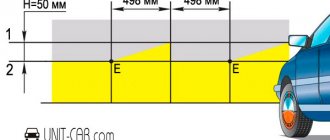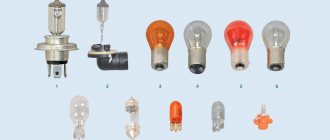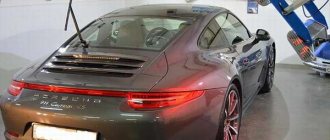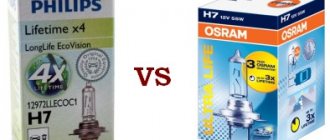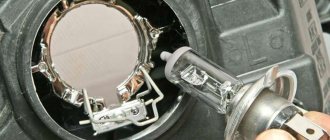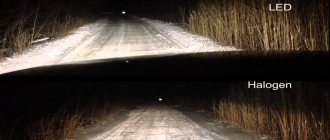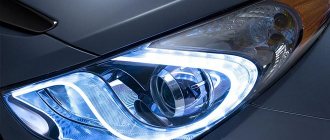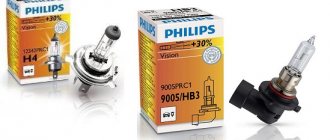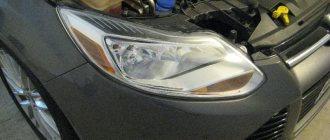MTF-Light H7
Lamp model from a Russian manufacturer. They are available in 3 luminous flux brightness options. There are warm white, white light and cool white, which guarantee excellent visibility at night. The power of such a lamp is 35 W, and the voltage is 85 V. The product can produce a luminous flux with brightness, depending on the model range, from 2600 to 3700 Lm. The lamp bulb itself is made of durable quartz glass, which perfectly blocks ultraviolet radiation. A rich glow is achieved through the use of a mixture of gases and metals. Also, such a lamp gains 80% brightness in five seconds.
Pros:
- Quick start;
- High brightness;
- Good resistance to vibration;
- Compatible with most control units.
Sho-Me H7
This lamp model is available in several color temperatures: 3000, 4300, 5000 and 6000 Kelvin. Such lamps can be used to equip low and high beam headlights. They are also used in fog lights. The lamps have a fairly long service life. According to manufacturers, such products can operate up to 3 thousand hours with standard daily use. The voltage of such a lamp ranges from 9 to 16 V, depending on the product range. Power is 35 W. The lamp is made of durable and shockproof glass that does not transmit sunlight. The manufacturer provides a warranty on lamps for up to 12 months.
- Pros:
- Many color temperature options;
- Optimal cost;
- Good light range;
- Not a bad guarantee;
- High quality build.
Minuses:
- There are known cases of manufacturing defects.
Usage
Xenon gas-discharge lamps are used not only for cars; they have a fairly wide range of uses. Depending on the design they are:
- Ball;
- Ceramic;
- Tubular.
Xenon balls are most widely used; they are used for headlights. Their design is a small flask filled with xenon. The electrodes are located at a very short distance.
Photo - round models
Ceramic ones are used in the pharmaceutical industry. Their feature is not only the use of a ceramic flask, but also the presence of a hole in it for ultraviolet light. This glow is used for therapeutic purposes, in particular, to detect fungal diseases of the skin or scalp.
Photo - ceramic
Tubular ones are devices for providing light in residential areas. Their electrodes are located at a fairly large distance from each other, so a certain ballast is required for operation. A throttle circuit of this type is used to provide illumination in large areas, often stations, warehouses and other industrial or public institutions.
Photo - tubular
Also, depending on the type of use, xenon lamps can have different sockets (for example, for a car - H8 4300K, H4 5000K, there are also options H7, H3, HB4 and H11).
Photo - plinths
Maxlux H7
Xenon lamps from South Korean manufacturers are very popular in the Russian automotive market. Such lamps have proven themselves to be reliable and high-quality products. The base of the lamps is H7 and they are available in three color temperatures: standard with white color 4300 K and with bluish shades 5000 and 6000 Kelvin. The voltage is 12 volts and the power consumption is 35 watts. The service life, according to manufacturers, is up to 20,000 hours with normal daily use of the product. The luminous flux produced by such a lamp is about 3000 lm. Also, such lamps can be used for low-beam, high-beam and fog headlights.
Pros:
- There is a choice of color temperature;
- High popularity;
- Excellent light brightness;
- Long service life;
- Optimal price.
SHO-ME 6000K Xenon 35W
Lamps for automobile headlights, low beam, high beam and fog lights. They have a bluish glow. The service life is approximately 3000 hours. The igniter is located directly on the lamp. The luminous flux with a power of 35 W has a very high intensity, which makes it possible to illuminate a wide area of the road. The lamp bulb itself is made of durable and transparent glass, which ensures low loss of luminous flux and maximum light output. The color temperature is 6000 K. The kit includes two lamps.
Pros:
- Blue glow color;
- Minimal loss of luminous flux;
- Long service life;
- High color temperature;
- Acceptable price.
Xenon lamps
- home
- Automotive lamps
- Xenon
- Xenon lamps
Sort by: default price name
Xenon lamp H11 Sho-Me 4300K 5000K 6000K
- Power: 35 W
- Light brightness: 2500 Lumens
545 rub.
399 rub.
Xenon lamp H8 Sho-Me 4300K 5000K 6000K
- Power: 35 W
- Light brightness: 2500 Lumens
545 rub.
399 rub.
Xenon lamp H7 Sho-Me 4300K 5000K 6000K
- Power: 35 W
- Light brightness: 2500 Lumens
545 rub.
399 rub.
Xenon lamp H4 Bi Sho-Me 4300K 5000K 6000K
- Power: 35 W
- Light brightness: 2500 Lumens
545 rub.
399 rub.
Xenon lamp H4 Bi-Xenon Sho-Me 4300K 5000K 6000K
- Power: 35 W
- Light brightness: 2500 Lumens
805 rub.
620 rub.
Xenon lamp H3 Sho-Me 4300K 5000K 6000K
- Power: 35 W
- Light brightness: 2500 Lumens
545 rub.
399 rub.
Xenon lamp H1 Sho-Me 4300K 5000K 6000K
- Power: 35 W
- Light brightness: 2500 Lumens
545 rub.
399 rub.
Xenon lamp HB4 9006 DLED
- Power: 35 W
- Light brightness: 2500 Lumens
645 rub.
399 rub.
Xenon lamp H1 DLED
- Power: 35 W
- Light brightness: 2500 Lumens
645 rub.
450 rub.
Xenon lamp H3 DLED
- Power: 35 W
- Light brightness: 2500 Lumens
645 rub.
450 rub.
Xenon lamp H4 DLED
- Power: 35 W
- Light brightness: 2500 Lumens
645 rub.
450 rub.
Xenon lamp H7 DLED
- Power: 35 W
- Light brightness: 2500 Lumens
645 rub.
450 rub.
Xenon lamp H8 DLED
- Power: 35 W
- Light brightness: 2500 Lumens
645 rub.
450 rub.
Xenon lamp H9 DLED
- Power: 35 W
- Light brightness: 2500 Lumens
645 rub.
450 rub.
Xenon lamp H10 DLED
- Power: 35 W
- Light brightness: 2500 Lumens
645 rub.
450 rub.
Xenon lamp H11 DLED
- Power: 35 W
- Light brightness: 2500 Lumens
645 rub.
450 rub.
Xenon lamp H13 DLED
- Power: 35 W
- Light brightness: 2500 Lumens
645 rub.
450 rub.
Xenon lamp H27 880 881 DLED
- Power: 35 W
- Light brightness: 2500 Lumens
645 rub.
450 rub.
Xenon lamp HB1 9004 DLED
- Power: 35 W
- Light brightness: 2500 Lumens
645 rub.
450 rub.
Xenon lamp HB3 9005 DLED
- Power: 35 W
- Light brightness: 2500 Lumens
645 rub.
450 rub.
Xenon lamp H16-PGJ19-3 Sho-Me 4300K 5000K 6000K
- Power: 35 W
- Light brightness: 2500 Lumens
545 rub.
399 rub.
Xenon lamp H16 DLED
- Power: 35 W
- Light brightness: 2500 Lumens
645 rub.
450 rub.
Xenon lamp PSX26W – MTF
- Power: 25 W
- Light brightness: 2000 Lumens
RUR 1,190
950 rub.
- " back
- 1
- All
- " forward
The xenon lamp is by far the most advanced technology in the field of automotive lighting. Quite often, many European car manufacturers install standard xenon bulbs to demonstrate the status of the car owner. The brightness of the low beam xenon lamp, which is what drivers most often replace, perfectly illuminates the road. Xenon is also suitable for replacing a halogen lamp in PTF and low beam; moreover, the car interior and many external parts are often tuned with the help of xenon lamps.
Among the huge variety of xenon lamps in Moscow and other large cities, which are presented in stores, there are 2 main criteria by which I classify lamps. Lamps are divided according to the type of base and arc length. Choosing which xenon lamp is better is quite difficult, since each type has its own advantages and disadvantages.
Xenon bulbs are classified according to the type of base:
- with D base
- with H base
- with HB base
Among xenon lamps with a D-type base, the following types stand out: s lamps are suitable for lensed optics, and r lamps are suitable for reflector ones. Typically, lamps with a D base are considered standard xenon.
- D1S – have a metal housing with an ignitor located under the lamp bulb
- D1R – have anti-reflective coating to eliminate glare
- D2S – resistant to temperature changes and vibrations
- D2R – vibration resistant and has a special coating
- D3R, D3S - new generation xenon lamps with a high level of safety
- D4S, D4R - the latest generation, due to the absence of mercury vapor, are considered one of the most environmentally friendly lamps.
Lamps with H socket are of the following types:
- H1 is a universal xenon lamp, that is, it is suitable for low beam, high beam and even PTF, therefore it is considered one of the most popular xenon lamps.
- H3 – due to its small size, it can be installed in fog lights
- H4 – used simultaneously for low and high beam headlights
- H7 – installed in low beam headlights
- H8 – rarely used, only for PTF
- H9 is also a fairly rare xenon lamp, mainly used as high beam in German cars
- H11 – found in the PTF of Japanese cars
- H27(880/881) – installed in the PTF of Korean cars
As for HB type lamps: HB2 (9004), HB5 (9007), they are used very rarely. HB3(9005) - usually installed in low beam, and HB4(9006) - in fog lights. The operating principle and design are identical to H-type xenon lamps.
It is quite simple for a car owner to decide which xenon lamp to buy for his car; it is enough to decide on its purpose, the desired brightness and the type of base. But choosing the best xenon lamp among others is more difficult.
All of them are made of durable material - quartz, the lamp bulb is securely sealed, which does not allow gas to escape beyond its limits. Inside, instead of an incandescent filament, which is present in conventional lamps, an electric arc is formed, glowing in xenon. To form it, you need a powerful charge, which transmits to the xenon bulb, through aluminum-titanium wires, the xenon ignition unit.
A xenon lamp has those advantages over a halogen lamp, thanks to which many car owners choose it as a replacement.
- Excellent brightness, which is several times higher than that of halogen
- Wide glow radius
- Long service life
- Safe use
- Energy Saving
All this gives reason to choose the best xenon lamp for your car and not think about replacing it for a long period of time, while the xenon glow will not strain the driver’s vision and blind oncoming cars, which will prevent the risk of getting into an accident.
BREVIA Max Power +50% 5500K 35W 12950MP
This xenon lamp model can serve as a good replacement for standard optics. The lamp produces 50% more light and a longer beam than a halogen lamp. The product increases comfort and safety when driving a car at night. Designed for installation in low beam, high beam and fog lamps. Xenon lamps heat up the headlight less and reduce the occurrence of cracks in them. These lamps are designed for cars with a H11/PGJ9-2 socket, which has two contacts. Power is 35 W. The bulb is made of durable glass and the color temperature is 5000 K. Two lamps are available per set.
Pros:
- Excellent build;
- High color temperature;
- Ensures traffic safety due to extensive lighting;
- Good value for money.
How to check the lamp for serviceability
New foreign cars are equipped with stock xenon with a mandatory headlight washer, since if the glass is dirty, the reflection deteriorates and the lamp is damaged. In addition, the manufacturer installs an auto-corrector for the height of the light beam. You can easily check it by rocking the car with the engine running.
If one of the xenon headlights does not light, you can replace it with another lamp. If there is no light and there is no light, you should suspect a faulty wiring or ignition unit. This element connects the car's standard electrical network with a xenon lamp. The functionality of the unit is checked with a multimeter or oscilloscope. These devices allow you to measure current, resistance and voltage in an electrical circuit.
To check the xenon lamp, it is necessary to determine the serviceability of the unit. The procedure is carried out after connecting the tester wires to the device sockets - black is installed on the negative terminal, red - on the positive terminal. More data can be obtained by using an oscilloscope.
How to check the xenon ignition unit:
- Clean the surface of the device with alcohol to remove rust.
- Inspect the housing for cracks. Seal any detected damage and, after the adhesive has dried, check the device again for functionality.
- If after repairing the case the device does not work, open it and inspect various elements.
The serviceability of transistors is checked using a tester. To do this, you need to connect the red probe to the base of the element, and the black probe to the collector. This is how the operation of a pn junction is checked in a direct connection - when conducting current. The breakdown voltage indicator appears on the display of the measuring device. Then you need to connect the black probe to the emitter, leaving the red one on the base. The display should again show the voltage that was when the probe was connected to the collector.
You can check the serviceability of pn junctions when turning them back on. In this mode, no current is conducted, and the display shows the number “1”.
To determine the functional terminals of the transistor - base, collector and emitter - it is worth connecting the positive probe to the middle of them (base), and the negative probe to any other. The higher resistance will be shown on the display when measuring the base-emitter junction.
MLux H11 6000K 35W Xenon
This lamp model is suitable for all types of cars. Its power is 35 W. The product guarantees a powerful luminous flux that does not fade, with a clear border and dark spots. Also, such lamps work perfectly in any weather conditions and at any time of the day. The service life is approximately 3000 hours with standard daily use. The color temperature is 6000 K, and the luminous flux is 2600 lm. The glow color of such lamps is bluish.
- Pros:
- Can work in several modes;
- High beam range;
- Does not blind oncoming cars;
- Long service life;
- High color temperature.
Why was xenon banned?
The ban on installing xenon lamps in certain types of headlights is due to the increased danger of driving. To understand why you cannot carry out such modifications yourself, it is worth highlighting a number of problems created by incorrectly installed xenon:
- Blinding of drivers of oncoming and passing cars by the light flux.
- Bi-xenon headlights do not improve visibility of the road: the beam of light extends a short distance in front of the car.
By law it is prohibited to install xenon in headlights of the wrong type.
What is the punishment
Since even the installation of xenon in the wrong type of lensed headlights leads to serious accidents on the roads, traffic police officers monitor drivers with upgraded lights.
Non-standard xenon is a violation of traffic rules, although there is no fine for xenon as such. If the headlights do not have special optics, the car is considered technically faulty and the driver faces punishment. His license is taken away for 6-12 months, the lamps are confiscated without the right to return.
A technical supervision inspector has the right to determine the presence of xenon on a car, as well as the light transmission of glass, only at a stationary traffic police post. A fine for xenon is not issued by itself.
What headlights can be installed in?
First, you should figure out when you can’t install xenon:
- HC/HR - this abbreviation on European cars means that only halogen bulbs can be installed on the headlight. Xenon is prohibited in this case.
- HCR - combination indicates that the optics have one dual-mode lamp. Xenon is also not installed in it.
- CR - except for incandescent lamps, it is prohibited to place any light sources in such optics.
You can install xenon headlights with the following designations:
- DR and DC. Xenon upgrade is allowed.
- DCR. This marking applies to machines equipped with one lamp operated in several modes. They are allowed to install xenon.
- HR and DC. It is prohibited to place xenon lamps in the high beam, but it is allowed in the low beam.
- HR and HC. If this designation is present, xenon installation is possible only on Japanese-made vehicles. This rule does not apply to cars from other countries.
If you install xenon headlights without a corrector and washer, the modification will be considered a violation.
Buyer's Guide: Questions and Answers
What are xenon lamps
Xenon is a chemical element of the periodic table, a gas that is odorless, tasteless and colorless. Currently, xenon is used in many areas, including in the manufacture of lamps used in cars. The production of xenon lamps began in 1992 and were installed only on expensive and luxury car models. Today, such lamps have become more accessible to all car enthusiasts.
To install xenon lamps, additional equipment will also be required. These are bi-xenon lenses - a device that provides focused and targeted light. The lenses distribute light evenly along the entire road, prevent glare and do not blind drivers of oncoming cars. Also, such lenses provide high beam and low beam, thanks to their design, which has magnets and curtains. You also need mono lenses. These devices provide only one light mode - low beam and are used mainly in fog lights.
How they work
Xenon lamps are a flask inside which contains mercury vapor and a mixture of inert gases with a large amount of xenon. There are also two electrodes in the flask, between which, with the help of ignition, by applying a powerful pulse under a voltage of 25,000 V, an electric arc is formed. Xenon combustion is ensured by the ionization of gas molecules and their movement. After the glow has been activated, a constant current supply of 85 V is needed, this promotes the combustion of the gas and prevents the lamp from going out.
Why do lamps shine differently?
If you notice that the lamps begin to glow, one with white light, and the other with blue or even pink, then there may be several reasons for this.
Of course, the first reason may be the lamp itself, its malfunction, or failure of the lamp itself. The fact is that the electrodes that are inside the lamp begin to burn over time and their effectiveness gradually decreases. Their melted remains settle on the walls of the flask. As a result, the contacts move away from each other, the electric arc is not so bright and the power of the light flux decreases. This is the reason for the color change. In this case, the lamp must be changed.
In the second case, the reason for the color change may be the lens. If the lens is of poor quality and, for example, is made of plastic and not glass, then over time it will begin to melt and thereby change the color of the lamp. You should also check the headlight for leaks. If water gets there, it can refract the light and change color.
In the third case, the cause of the color change may be the ignition unit and high-voltage coil. The ignition unit is a high voltage transformer that converts 12V to 25000V for a few milliseconds to light the lamp, then it simply maintains 50-70V to keep the lamp burning. In such a transformer, the pulse transformer, rectifier diode or capacitor may fail. If the capacitor fails, then it is not able to supply the correct pulses to the high-voltage coils, as a result of which the arc in the lamp will either not burn at all, or will burn in a different color and much weaker.
High-voltage coils burn out immediately; if they fail, the lamp will not work because of this.
The fourth reason could be wiring. If water or condensation gets on it. In this case, you just need to check the wires and replace the burnt area.
Also, the reason for the color change may be the replacement of one lamp. If one lamp fails, you need to change both of them at once. Since xenon changes color over time. That is why a new lamp and a lamp that has worked for a couple of years will shine in different colors.
How often should lamps be changed?
Here everything depends individually. Typically, lamps burn out in 2-2.5 years. But according to reviews from drivers, if they are constantly used with the headlights on, the lamps need to be changed after a year or a year and a half.
Why do they go out periodically?
The reason why the lamps go out may be a fault in the wiring, contacts, or a defect in the lamp itself. You need to install a new lamp and if it goes out after a few minutes, swap the lamps. If the same headlight goes out again, then most likely there is a fault in the ignition unit or in the wiring. If a new lamp in another headlight goes out, then this is an obvious defect in the lamp itself.
Why do they flicker?
If the lamp begins to flicker, then most likely this is damage to the contacts in the lamp socket and electrical erosion has appeared on them. In this case, you will have to buy a new cartridge, since it cannot be restored.
How to choose
The first thing you need to pay attention to when choosing a lamp is the base. The socket is a special mount with which the lamp is attached to the socket. and electric current is supplied through it. Low and high beam headlights, and fog lights use lamps with different sockets. Also, the base of the bulbs for the same headlights may differ from the car model.
If you have a European brand of car, then they most often use bulbs with H1 and H7 sockets for low beam, H1 socket for high beams and HB3 socket for fog lights. In cars of Asian brands, lamps with an HB4 base are used in low-beam headlights, lamps with an H3 base in high-beam headlights, and H11 in fog lights. For American car brands there is no clear pattern for light bulb sockets. To find out which base is suitable for your car, you need to carefully study the instructions or find out information via the Internet.
Which light bulbs should you not buy?
When choosing a lamp, you need to carefully consider it and pay attention to the following points:
- Look carefully at how the xenon lamp bulb is positioned. Its location should coincide with the filament of a regular light bulb, which is very important. If the ball is shifted to the left or right, this may cause the headlights to become out of focus and their light will blind drivers of oncoming cars.
- If the flask itself is of good quality, then it should be mounted on metal or ceramics. In no case should it be attached with glue, since under the influence of high temperature the glue will melt and the light bulb will change its angle, which is unacceptable.
- Also, when choosing a light bulb, you should not focus on branded models or the most expensive ones. The cost of such products includes considerable advertising and marketing costs.
- But the cheapest ones are also not worth purchasing. In such lamps, the xenon is most likely of poor quality and you will get poor light, parts malfunctions and an unplanned visit to the service station.
How to change a xenon lamp yourself
The process of replacing xenon lamps is not always simple and cheap. In some cars, it is impossible to replace the lamps yourself due to the design of the car. In this case, you will have to contact customer service. But if the design of the car allows you to replace the xenon lamps yourself, then the first thing you need to do is read the instructions. But not all manufacturers indicate in the instructions how to replace the light source.
If you did not find such information in the manual for your car, do not be surprised, this is quite understandable. Most often this is due to the design features of your car and the labor-intensive process of replacing the light source. In any case, you must be very careful with xenon lamps, since such lamps pose a very high risk of electric shock.
Therefore, we do not recommend replacing burnt-out xenon lamps yourself. This should only be performed by a specialist.
Design and principle of operation
There is no filament filament in the design of xenon lamps. It is replaced by an electrical discharge that appears between electrodes placed in an elliptical flask. It is in it that xenon gas is mixed with metal salts. The mixture is pumped under pressure. When using the product, a strong beam of light is formed, exceeding the intensity of halogen bulbs. Therefore, special lenses and a reflector are installed with xenon light.
Xenon optics, which are equipped with headlight washers and dynamic corrector, help prevent dazzling other drivers on the road. The latter has a rather high price, but is especially necessary for such tuning. Headlight washers prevent light from scattering through mud-splattered windows. When installing xenon optics on a used car, light adjustment is carried out using a stationary device.
The color of the lamps depends on the temperature (measured in Kelvin) to which the gas in the bulb is heated. The range of modern light sources includes the following types:
- Xenon 3000k shines with a warm yellowish tint - it can only be installed in foglights.
- 4300k has a milky white light - it is installed at the factory.
- 5000k – white.
- 6000k – blue crystal.
Since xenon lamps do not have an incandescent filament, in the first years of their use there were difficulties with turning on the low and high beams. Xenon light sources were installed only on cars with 4 reflectors. However, modern optics are represented by two bi-xenon designs. In simple products, xenon bulbs are displaced in one base. Bi-xenon headlights are devices equipped with a curtain to partially cover the reflector. Modern optics have a drive that moves the lamp horizontally, providing different modes of road illumination.
Marking
Conventional light bulbs, according to GOST, have the following markings:
- C – low beam;
- R – long range;
- CR – dual-mode.
The headlight designation for xenon should be written with the letter “D”, and for halogen – “H”. If the car owner installs such lamps, he must ensure that the optics have the appropriate markings.
On many cars, the headlight markings are located on their glass part, on the back or on top. In the latter cases, you will need to open the hood. On some models you will need to remove the headlight. It is worth considering a product marked:
- The designation “1” is located on the left and indicates the type of headlight: A – side, B – fog, C – low beam, R – high beam, CR or C/R – low and high beam, respectively.
- The designation “2” refers to the type of lamp, for example, HCR or DC.
- The number “3” has several interpretations and looks like “E15”. The first letter denotes an international standard (E - for European-made cars, DOT or SAE - for cars from the USA). Next to the letter there is a number - the code of the country of origin.
- The designation “4” looks like an arrow, one- or two-directional. If it points to the right, it means the optics are designed for countries with right-hand traffic. In universal products, headlights have bidirectional arrows.
Using these designations, you can determine the type of light bulbs that can be installed in car optics.
Comparison with other types of headlights and which is better
Xenon headlights, like LED ice lamps, are gradually replacing halogen ones. Their light can be compared to daylight, whereas with old lamps it has a yellow tint and tires the driver’s eyes faster. Light from incandescent lamps, like from halogen lamps, is scattered due to the specific design of the headlights. Xenon forms a beam of rays through the use of lenses.
